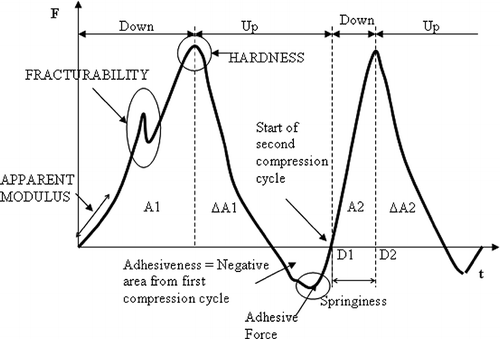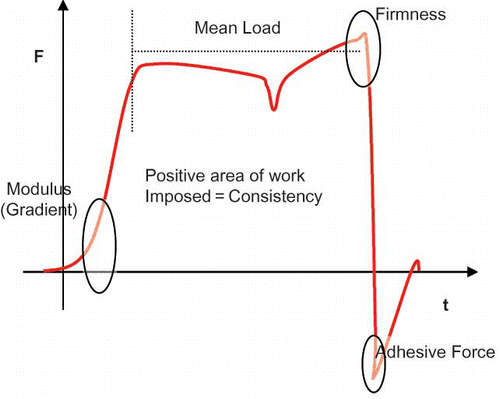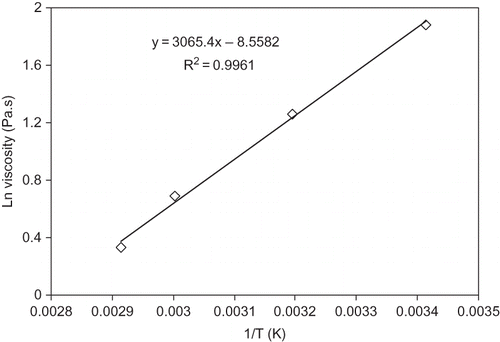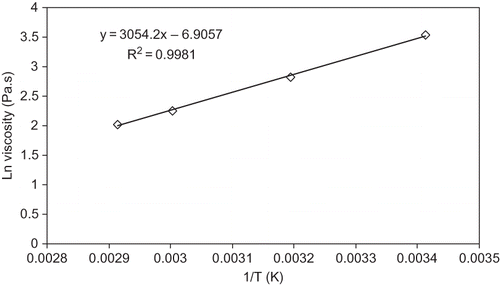Abstract
The rheological properties of two commercial date pastes were investigated in the temperature range of 20–70°C. From typical flow behavior curves, it was observed that date pastes exhibited pseudoplastic behavior. The shear stress-shear rate data were fitted using six common rheological models. The Casson model best described the experimental data at all temperatures. The Arrhenius model described successfully the temperature dependence of apparent viscosity of date pastes (R2 > 0.99) with an Ea value in the range of 25,392.6–25,485.7 kJ/kmol. The textural attributes measured were: hardness, springiness, gumminess, cohesiveness, chewiness, and adhesiveness for the texture profile analysis test, and firmness, adhesive force, mean load, and total positive area for the Ottawa test. There was a significant difference in textural attributes between two varieties of date paste studied. Texture profile analysis results showed that all parameters obtained for black date pastes were higher than golden date pastes except for springiness and cohesiveness. However, the Ottawa results showed that golden date pastes were firmer and less adhesive than black date pastes.
INTRODUCTION
Among the agricultural commodities of commercial importance in Iran, dates are of particular interest. Date palm is the most successful and extremely important subsistence crop in the producing countries with significant increases in yield occurring after adopting advanced biotechnological approach. However, date processing industries have not expanded at the same rate. Today, there is new interest in the date as a component of new food formulations/preparations.Citation[1,Citation2] There is enormous potential for fresh dates and date products with better quality attributes. Date processing industries are producing various date products like date paste, date syrup, date dip, date honey, date jam, date vinegar, and so on.Citation[3] Generally a date is steamed, de-stoned, macerated, and converted to a semi-solid form, known as paste, with approximately 20–23 g/100 g sample moisture content and a water activity below 0.6.Citation[3] Date paste has been used as filler and also sugar substitute in many food formulations.Citation[4] The confectionary industries have been utilizing date paste as one of the major ingredients for some time.Citation[5] The possibility of using date paste as a replacement for caramel or sugar paste in preparing candy bars was also studied in terms of processing conditions, nutritive value, and organoleptic properties of the prepared date bars, as well as their storability were evaluated.Citation[6]
To assess the quality of semi-solid food products, it is necessary to understand their rheological properties. Rheological properties of foods are of great importance for several reasons especially in sensory evaluation, quality control, process design of flow equipments (mixing, pumping, heating, cooling, filling, etc.), new product development, process scale-up, and optimization of process variables.Citation[7] Also, rheological measurements have been considered as an analytical tool to provide fundamental insights on the structural organization of food and play an important role to semi–solid foods. The rheological properties were strongly influenced by temperature, concentration, and physical state of food products. Texture is the most important factor for determining the overall quality and consumer acceptability of fresh fruits and vegetables. Traditionally, textural assessments have been carried out by taste panels, which may or may not be formally trained in the appraisal of textural characteristics. Defining the textural properties and their relative magnitude with respect to other similar products will increasingly become a critical criterion for food manufacturers seeking to design new products, maintain the quality of current ones, or understand strengths and weaknesses relative to their competitors. Instrumental Texture Profile Analysis (TPA) technique has been used to characterize textural attributes of solid foods from empirical to instrumental results. The most notable early development in this area was made by Szczesniak and co-workers, in which it was attempted to classify textural properties, for example hardness, adhesiveness, cohesiveness, and elastic quality, and propose scientific methods for their measurement.Citation[8]
Rheological properties of date pulp (15 and 45°Brix) and concentrates (73°Brix) were analyzed by El-Samahy et al.Citation[9] They determined flow behavior parameters based on different rheological models (Power Law, Bingham, and IPC paste). They also studied the effect of temperature on the rheological characteristics of date concentrate and date pulp, and calculated the activation energy based on Arrhenius type model. Physico-chemical properties of date pastes were investigated by Ahmed and Ramaswamy.Citation[1] They measured dynamic rheology, tristimulus color, TPA, and thermal properties (differential scanning calorimetry) of three date pastes. Instrumental TPA of date flesh as a function of moisture content was studied by Rahman and Al-Farsi.Citation[10] A survey of the literature showed that less information was reported on the rheological properties of date pastes. The objective of the present work was to evaluate the rheological properties of two commercial Iranian date pastes. In this paper, the textural quality attributes of two commercial date pastes investigated by the instrumental TPA and Ottawa tests, while flow behavior properties and temperature dependency studied by steady shear viscometery. Meanwhile, the shear stress-shear rate data were fitted to six famous rheological models in order to select the best model describing the flow behavior of date paste.
MATERIALS AND METHODS
Materials
Two date fruits of varieties, namely Mordab Sang from Kerman province and Maktoom from Fars province of Iran, were harvested and their pastes produced by the Saberi factory in Mashhad, Iran. The trademark names of these date pastes were Golden and Black date pastes, respectively. Soluble solids (°Brix) were measured with a digital hand-held Refractometer (Model PAL-α, Atago Com, Korea) and total solids were determined by the vacuum drying method (70°C, 25 mmHg and for 48 h). Samples were also analyzed for pH with a pH meter (Jenway 3020, UK). The average chemical characteristics of date paste samples used in this study is summarized in .
Table 1 Chemical parameters of date pastesFootnote a
Instrumental Texture Profile Analysis (TPA)
For the two-cycle compression, a texture analyzer QTS (CNS Farnell Company, U.K.) was used to measure the TPA of date pastes. All measurements were carried out in a controlled room temperature. The cross-head was allowed to penetrate with a cylindrical probe (25 mm diameter) at the rate of 30 mm/min to a total deformation 20 mm and back to the original position followed by a second down and up cycle on the same sample. Six replicates were conducted for each date paste sample and all operations were automatically controlled by the Texture Analyzer. The following parameters were extracted from the generalized instrumental texture profile curve (): hardness cycle 1, gumminess, chewiness, adhesiveness, springiness, cohesiveness, adhesive force, hardness cycle 2, area cycle 1, and area cycle 2. Hardness is defined as the force necessary to attain a given deformation or a penetration in a product.Citation[8] Area cycle 1 (A 1 in ) is the total energy required for the first compression and area cycle 2 (A 2 in ) is the total energy required for the second compression. Cohesiveness (shown as A 2/A 1 in ) is the extent to which a material can be deformed before it ruptures. Springiness (or elasticity) is the rate at which a deformed material goes back to its un-deformed condition after the deforming force is removed. Adhesiveness is the work necessary to overcome the attractive forces between the surface of the food and the surface of the other materials with which the food comes in contact. Chewiness is the energy required to masticate a solid food to a state ready for swallowing, or a product of hardness, cohesiveness, and springiness. Gumminess is the energy required to disintegrate a semi-solid food to a state ready for swallowing, or a product of a low degree of hardness and a high degree of cohesiveness.Citation[11]
Figure 1 Generalized instrumental texture profile curve obtained with the General Foods Texturometer (CitationSzczesniak, 2002)

Forward Extrusion Test (Ottawa Cell)
The Ottawa test jig used consists of a square test cell with solid walls and an open base which can be fitted with a plate. A square plunger (43 mm × 43 mm) is fitted to the machine crosshead and provides the compression. The test method involves weighing a suitable quantity of sample which is placed in the cell with a slotted plate fitted (83 × 4 mm Ø holes). The result was determined by measuring the resulting force required to extrude the sample. The cross head was allowed to penetrate at the rate of 30 mm/min to a total deformation 40 mm and back to the original situation. The mechanical parameters of this test, such as firmness, adhesive force, mean load, and total positive area (area cycle 1), were extracted by the Texture Analyzer software from the load-time and load-deformation curves (). The firmness is defined as the force required extruding the specimen through the insert to a specified extrusion distance. Adhesive force is the maximum negative force generated during upstroke of probe. Total positive area is the positive area to firmness ().
Flow Properties Measurement
Rheological parameters of date pastes were measured by a Bohlin Visco 88 viscometer (Bohlin instrument, UK) equipped with a cone and plate geometry (cone diameter 30 mm, cone angle 5°) and a heating circulator (Julabo, Model F12-MC, Julabo Labortechnik, Germany). The flow curves of date pastes were determined at four temperature levels of 20, 40, 60, and 70°C by increasing the shear rate from 14 to 500 s−1. The shear rate increased up to 500 s−1 for Golden date paste and up to 60 S−1 for the other one. The shear stress-shear rate data were then fitted using six famous models known as Power law (EquationEq. 1), Bingham plastic (EquationEq. 2), Herschel–Bulkley (EquationEq. 3), Casson (EquationEq. 4), Sisko (EquationEq. 5), and Vocaclo (EquationEq. 6).Citation[12] To select the best model describing time-independent rheological properties of date paste samples, the coefficient of determination (R 2) was obtained for the six aforementioned rheological models.
where, τ is the shear stress (Pa), is the shear rate (s−1), kP
is the Power law consistency coefficient (Pa.sn
), and nP
is the Power law flow behavior index (dimensionless).
where, τ0B is the Bingham yield stress (Pa) and η B is the Bingham plastic viscosity (Pa.s).
where, τ0H is the Heschel-Bulkley yield stress (Pa), kH is the consistency index for Herschel-Bulkley model (Pa.sn ), and nH is flow behavior index for this model.
where, k
0C
and kC
are the intercept and slope of plot of versus
, respectively. Therefore, the Casson yield stress (τ0C
, Pa) and Casson viscosity (η
C
, Pa.s) were calculated as the square of the intercept and slope, respectively [τ0C
= (k
0C
)2), η
C
= (kC
)2].
where, η is the apparent viscosity (Pa.s) and η∞ is the viscosity at high shear rate (Pa.s).
where, kv is the consistency index for Vocadlo model (Pa1/n .s) and nv is flow behavior index for this model. There is considerable evidence that the influence of temperature on viscosity, for a semi–solid food, may be described by an Arrhenius–type relationship as follows:
where, η0 is the proportionality constant or viscosity at infinite temperature (Pa.s), Ea is the activation energy (kJ/kmol), T is the absolute temperature (K), and R is the gas constant (kJ/kmol.K).
RESULTS AND DISCUSSION
Instrumental Texture Profile Analysis
The TPA of date pastes is shown in . Hardness cycles 1 and 2, gumminess, cohesiveness, springiness, and area cycle 1 were not significant between date paste samples analyzed in this study. Among analyzed parameters adhesiveness, chewiness, area cycle 2 at p < 0.05, and adhesive force at p < 0.01 were significant. Cohesiveness, springiness, and area cycles 1 and 2 were higher for Golden date paste than Black date paste. While, the adhesive force and adhesiveness obtained lower. Rahman and Al-FarsiCitation[10] reported a significant different value for date flesh. However, cohesiveness and springiness values obtained here were very close to those evaluated by Ahmed and RamaswamyCitation[1] for date pastes.
Table 2 Instrumental texture profile analysis (TPA) of date paste
Forward Extrusion
The Ottawa cell is designed to produce shear stresses in a specimen by forward extrusion. As the plunger of the Ottawa cell is moved down the food specimen is compressed. As deformation continues, the food is extruded through an insert in the bottom of the cell. This technique is ideally suited for testing beans, fruit fillings, pastes, soft vegetables, mashed potato, and snack products. The results of forward extrusion analysis of date pastes are summarized in . It can be found that the firmness and total positive area were different between two varieties (p < 0.01). Firmness and total positive area were higher for Golden date paste than Black date paste, while the adhesive force and mean load were lower for Golden paste. These data confirm TPA results obtained in this study.
Table 3 Forward extrusion analysis (Ottawa test) of date paste
Flow Behavior
Fluid rheological parameters of date pastes were measured at different temperatures and the shear stress–shear rate data of date pastes were tested for various rheological models (). It can be found that Sisko and Vocadlo models were not fitted at all the rheological data for two date pastes at different temperatures. The Bingham and Power law models fitted on the flow behavior data adequately at lower temperatures and failed at higher temperature. The Herschel–Bulkley model was not suitable for Black date paste at all temperatures and for Golden date paste at higher temperatures either, while the Casson model fitted well the shear stress-shear rate data obtained for both date pastes at each temperature ().
Table 4 Flow behavior parameters of date pastes obtained by some rheological models at different temperatures studiedFootnote a
The apparent viscosity values of two date pastes at different shear rates are shown in and as a function of temperature. These figures confirm the shear thinning behavior of date pastes at selected temperatures. At low shear rate, the apparent viscosity was varied significantly in the temperature range of 20–70°C for Golden date paste (), however at shear rates higher than 300 s−1, the viscosity was not decreased with shear rate and was almost constant, which represent the Newtonian region at high shear rates.
Apparent viscosity decreased with an increase in temperature. For Golden paste, Casson yield stress (τ0C ) decreased by increasing temperature, but such kind of behavior was not found for Black date paste. Increasing temperature decreased Bingham yield stress (τ0B ) and Bingham viscosity (η B ) for two date pastes. El-Samahy et al.Citation[9] analyzed the rheological properties of date pulp and date concentrate. They reported that date pulp is pseudoplastic fluid and showed that the consistency coefficient “k” increases exponentially with increasing the soluble solids of the juice and it decreases sharply at higher temperatures. Temperature had a relatively small effect on the flow behavior index (n) of date pulp samples. They also concluded that the rheological parameters of date concentrate (k and n) gradually decreased by increasing temperature.
and show the Arrhenius type behavior between the experimental apparent viscosity of Golden and Black date pastes and the inverse absolute temperature, respectively. Activation energy (Ea ) indicates the sensitivity of the viscosity to the temperature change. The activation energy of Golden and Black date pastes ranged between 25,485.7 and 25,392.6 kJ/kmol, respectively, while the corresponding proportionality constants (η0) were 1.92 × 10−4 and 1.002 × 10−3 Pa.s, respectively. The R 2 value for both cases were 0.99, indicating that Arrhenius model was successful in describing the temperature dependency of apparent viscosity. El-Samahy et al.Citation[9] determined activation energy for date pulp and concentrate and reported that the activation energy was increased as the total solids of date pulps increased. Date concentrates had higher activation energy compared with those for date pulp. Activation energies observed in this research were much higher than date pulp at 15 and 45°Brix and were lower than date concentrates reported by El-Samahy et al.Citation[9] The Ea and η0 data obtained here were also higher than those reported for tamarind juice concentrates.Citation[13] However, the values of constants were close to the values obtained for starch at 4% and pectin at 5% concentrations.Citation[14]
CONCLUSION
Date paste showed a non-Newtonian behavior, the relationship between viscosity and shear rate was non-linear. Date pastes exhibited the shear-thinning pseudoplastic behavior. The model that best fitted the experimental data at all temperatures was Casson model. The viscosity decreased with increase of temperature. The textural attributes are significant parameters for semi-solid products, such as date pastes. These parameters are very important for determining the overall quality and consumer acceptability of products. These parameters would help the process industries to design new food products, machineries, and quality control. According to the textural results obtained, cohesiveness, springiness, area cycles 1 and 2, firmness, and total positive area were higher for Golden date paste than Black date paste, while adhesive force, adhesiveness, gumminess, chewiness, hardness cycle 2, and mean load were observed low.
REFERENCES
- Ahmed , J. and Ramaswamy , H.S. 2006 . Physico-chemical properties of commercial date pastes (Phoenix dactylifera) . Journal of Food Engineering , 76 : 348 – 352 .
- Razavi , S.M.A. , Habibi Najafi , M.B. and Alaee , Z. 2008 . Rheological characterization of low fat sesame paste/date syrup blends in the presence of fat substitutes . International Journal of Food Properties , 11 : 92 – 101 .
- Ahmed , J. , Ramaswamy , H.S. and Khan , A.R. 2005 . Effect of water activity on glass transitions of date pastes . Journal of Food Engineering , 66 ( 2 ) : 253 – 258 .
- Al-Rawahi , A. , Kasapis , S. and Al-Bulushi , I. 2005 . Development of a date confectionery: Part 1. Relating formulation to instrumental texture . International Journal of Food Properties , 8 ( 3 ) : 457 – 468 .
- Hassan , B.H. , Alhamdan , A.M. and Elansari , A.M. 2005 . Stress relaxation of dates at khalal and rutab stages of maturity . Journal of Food Engineering , 66 : 439 – 445 .
- Yousif , A.K. , Morton , I.D. and Mustafa , A.I. 1991 . Functionality of date paste in breadmaking . Cereal Chemistry , 68 ( 1 ) : 43 – 47 .
- Steffe , J.F. and Daubert , C.R. 2006 . Bioprocessing Pipelines: Rheology and Analysis , East Lansing , MI : Freeman Press .
- Szczesniak , A. , Brandt , M. and Freidman , H. 1963 . Development of standard rating scales for mechanical parameters and correlation between the objective and sensory texture measurements . Food Technology , 22 : 50 – 54 .
- El-Samahy , S.K. , Abd El-Hady , E.A. , Mostafa , G.A. and Youssef , K.M. 2006 . Rheological properties of date pulp and concentrate . Proceedings of the 4th International Symposium on Food Rheology and Structure , : 583 – 584 .
- Rahman , M.S. and Al-Farsi , S.A. 2005 . Instrumental texture profile analysis (TPA) of date flesh as a function of moisture content . Journal of Food Engineering , 66 : 505 – 511 .
- Szczesniak , A. 2002 . Texture is a sensory property . Food Quality and Preference , 13 ( 4 ) : 215 – 225 .
- Rao , M.A. 1999 . Rheology of Fluid and Semisolid Foods, Principles and Applications , Maryland : Aspen Publishers, Inc .
- Ahmed , J. , Ramaswamy , H.S. and Sashidhar , K.C. 2007 . Rheological characteristics of tamarind (Tamarindus indica L.) juice concentrates . Lebensmittel-Wissenschaft und-Technologie (LWT) , 40 : 225 – 231 .
- Marcotte , M. and Ramaswamy , H.S. 2001 . Rheological properties of selected hydrocolloids as a function of concentration and temperature . Food Research International , 34 : 695 – 703 .




